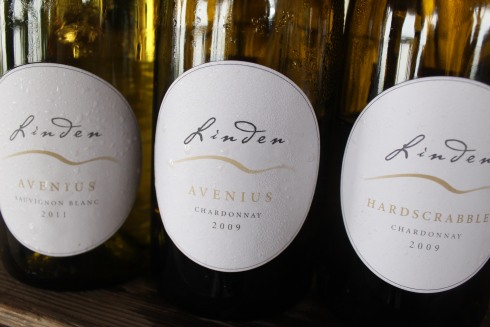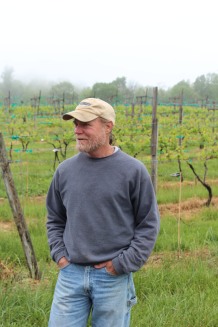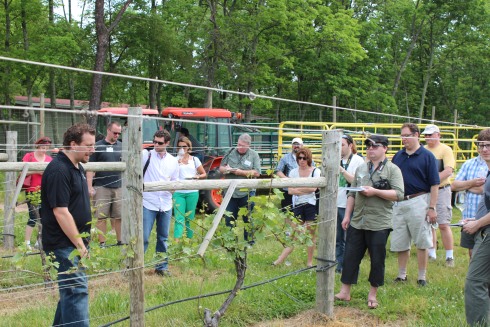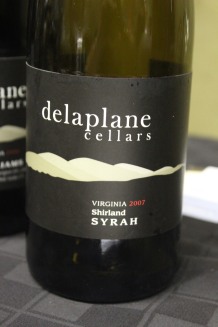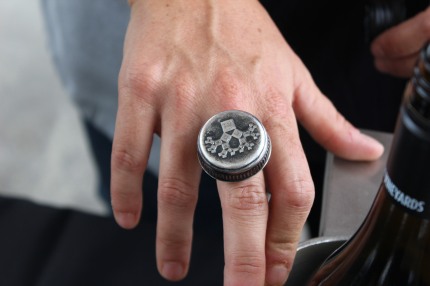Since it’s been so long since Taste Camp, I seriously considered not returning to my posts on our experiences, but since the weekend ended with a visit to Linden Vineyards and time talking with owner/winemaker Jim Law, I decided to get over my feelings of embarrassment for my slacker blogger ways and share some of what I learned.
In case you’re a VA wine lover who’s been living under a rock for a few decades…apologies in advance to anyone who actually does live under a rock…Linden is typically viewed as one of, if not the, premier winery in the state. Moreover, Jim Law has served as a vineyard and cellar mentor and advisor to many. For reasons totally unknown to us now, it took us far too long to make our first visit to Linden, but we were quickly sold on the quality and consistency of his wines. The opportunity to learn directly from Law was a huge draw for me in making Taste Camp fit into my incredibly busy spring schedule.
On Sunday, Law welcomed a bunch of tired but excited bloggers for a vineyard walk at his Hardscrabble site followed by a tasting of some of his single vineyard wines. He started by telling us a bit about himself, and it really just made me want to share some food and wine with him as I encouraged him to talk about his life (anyone able to hook this up for me….anyone?). He was a poli sci major who joined the Peace Corps where he was growing fruit crops in Africa. Given that he grew up in a wine loving family, he looked into growing grapes/making wine when he returned to the US and spent some time in Ohio where he found that he loved it. He looked to the coasts for his own vineyard/winery as that typically meant a wine buying public more interested in dry wines (it may be a stereotype, but cut him some slack since it was more than 30 years ago). He felt that the west coast was “too established” and his “Peace Corps spirit” brought him to VA. Yay for us!
If you’ve been to Linden, you know that he has a beautiful, hilly vineyard. More important, he has good soil, drainage, airflow, etc. This was not random. As is true with just about all the best vineyards in the state, he went looking for the “right” site. After all, just because grapes will grow somewhere doesn’t mean it’s the optimal location for them. Anyway, Law (it just feels wrong for me to call this man by his first name) said the 80s were really focused more on climate and drainage issues in VA. He’s now focusing more on soil and experimentation with clones. While he still thinks we’re many years away from really knowing which clones do best in VA, and different parts of VA, he’s now ripping out most of his original plantings and replanting over a 5-10 year period with more attention to what should be planted where based on soil since it varies widely throughout his vineyard. Yes, he’s sacrificing fruit from established vines, but he’s taking a much longer-term view.
I already talked about vineyard issues that came up throughout our Taste Camp visits in another post, so I won’t rehash them here. You should be aware, however, that Linden offers a vineyard/cellar tour on weekends at 11:30. If you can work this into your schedule, do so. You won’t regret it. Ask questions about the vineyard choices being made regarding new plantings, spacing, clones, etc. You’ll learn a lot and gain a deeper insight into the wine industry. My guess is, like me, you’ll quickly come to understand the Linden tagline “never content.” It sounds tiring and depressing, but it’s a philosophy I embrace in many aspects of my own life. Contentment can equate with laziness or too much satisfaction with the status quo. Life is about growth and change, and Law clearly embraces this. I so want to be him, in my own profession of course, when I grow up.
Anyway, you probably want to hear about the wine… You’re likely aware that Linden offers 2 “levels” of wines: single vineyard wines and non-vineyard designate wines. The single vineyard wines are from either the Hardscrabble, Avenius, or Boisseau sites. Hardscrabble is the “home” vineyard. It’s the largest, has more granite in the soil, and seems to do well for cab sauv according to Law. The other two sites are managed by and leased from long-time colleagues of Law. Avenius is a cooler site at a slightly higher elevation which makes it hard to ripen some reds. He thinks this site is stronger for chard, sauv blanc, and merlot. The Boisseau site is just into the Shenandoah Valley, is at a lower elevation, tends to be warmer, and has richer soils. He says this site tends to show well for younger/crowd pleaser wines that are very fruit driven. The non-vineyard designate wines are comprised of fruit from any or all of these sites that either didn’t make the cut to be in a designate wine or was extra. Law also has a few wines in this category that are more “production wines,” like his vidal-riesling and seyval, that were never intended to be vineyard designate as they don’t particularly speak to terrior.
Anyway, Law gathered us on the crush pad as fog rolled up the mountain to taste some wines from both the Avenius and Hardscrabble sites. We began with the ’11 Avenius sauv blanc. 2011 was a challenging year, but I appreciate the acidity and low alcohol in this wine. That said, I’m guessing the acid will be a bit much for some people – although Law says it should integrate a bit over the next few months. I noted a lot of lemongrass along with some boxwood and other herbal notes and finally some green apple on the finish. We then moved on to the ’09 Avenius chard. This wine is aged in old oak barrels, so the influence of the oak is barely noticeable. There was only a slight hint of vanilla – I primarily noted some bright citrus notes and minerality. This is my style of chardonnay. FYI – Law said that Avenius chards typically peak around 5-7 years. The final white was the ’09 Hardscrabble chard. This one underwent partial malolactic fermentation, so I did note more butter and vanilla notes, especially on the nose, but I really appreciated that there was still a good backbone of acid to the wine. That said, Law said that this was still a very young wine, so it needs more time to develop.
For reds, we tried the ’08 Hardscrabble and Avenius red blends. The Hardscrabble is a cab dominant wine, and I got a lot of wild berry notes along with some earthy hints. Its a soft wine that’s drinking well now but still has plenty of time to grow and change in the bottle. The Avenius was definitely driven by petit verdot, and those dark fruit flavors just coated my mouth. This was a big wine.
You might wonder why Law didn’t pull out any of his ’07s for us since so many people rave about ’07 as one of the best growing years in VA, especially for reds. Well, Law said that he prefers the “typical” years like ’08 and ’09 as opposed to the hot, dry years of ’07 and ’10. He’s all about balance, and those huge fruity, higher alcohol wines from ’07 and ’10 are less representative of his style or taste. One of the big advantages for me about participating in Taste Camp was the opportunity to try a wide array of wines from many vineyards and vintages in a short period of time. While I do enjoy those big ’07s from time to time, when I’m looking for a wine to have with dinner, I do tend to reach for those from the more “typical” vintages. What this means for me is that I have to watch for those in the future and stock up when I can.
Anyway, as you might have guessed from this long post that I had a great time and learned a lot. Thanks Taste Camp, Linden Vineyards, and Jim Law for making this happen. It was nice to follow a master, who knows he also still needs to be a student, through his vineyard and hear about his experiences, challenges, and insights. I’m an academic by both training and inclination, so Law’s lifetime learning approach to vineyard management and winemaking resonates with me. Plus passion is contagious. If you haven’t been to Linden in a while, plan a visit. It will be worth your time.






